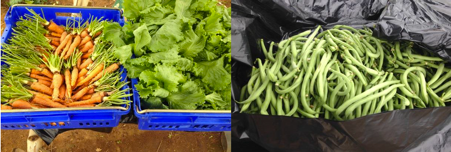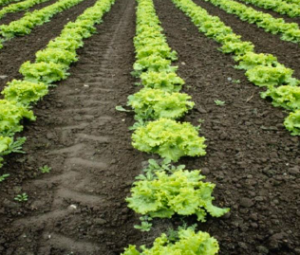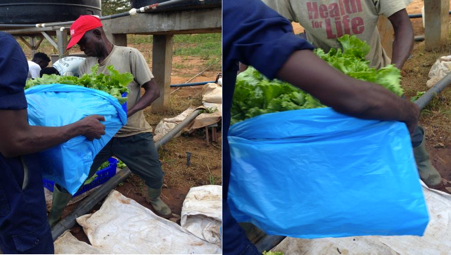It is another “Veges Season” and you know it’s just about time to ignite smiles on the faces of stressed and hungry staff. It gives us great joy to see and hear people happy whenever they are served with meals garnished with vegetables from their own farm. To us on the vegetable farm, it’s not just about the garnished meals but the assurance of Blue Skies people eating fresh and hygienic straight-from-farm vegetables. Our vegetables have the right nutrients intact due to the proper agronomic practices employed on our fields. It is fulfilling to know that indirectly we are positively influencing the health of Blue Skies people.
This season nursing and planting started in June and as we said in our last publication, other practices have been learnt and has so far been inculcated in our field activities. Much improvement has been seen in the vegetative growth of plants and we are highly optimistic that it is going to be a great season. Already, harvesting has started. Several supplies of lettuce and French beans have been made to the canteen already and more would follow up soon. An all-year-round program has been drawn to enable a constant supply of vegetables throughout the year.

To ensure our consumers know what they take in, we are using this platform to educate people on the physiology and health benefits of the various vegetables we cultivate. This month has been dubbed “The Lettuce Month”and we are going to plunge into the nitty-gritties of this vegetable.
LETTUCE
General Information: Lettuce (Lactuca sativa) is an annual plant of the daisy family Asteraceae. It is most often grown as a leafy vegetable, but sometimes for its stem and seeds. Lettuce is a rich source of vitamin K and vitamin A, and is a moderate source of folate and iron.
 Planting: Before you plant your lettuce seeds, make sure the soil is prepared. It should be loose and drain well so it’s moist without staying soggy. To keep the soil fertile, feed it with organic matter about one week before you nurse your seed and transplant. Since the seed is so small, a well-tilled seedbed is essential. Large clods will reduce germination.
Planting: Before you plant your lettuce seeds, make sure the soil is prepared. It should be loose and drain well so it’s moist without staying soggy. To keep the soil fertile, feed it with organic matter about one week before you nurse your seed and transplant. Since the seed is so small, a well-tilled seedbed is essential. Large clods will reduce germination.
Uses: Lettuce is most often used for salads, although it is also seen in other kinds of food, such as soups, sandwiches and wraps; it can also be grilled. One variety, the woju, or asparagus lettuce, is grown for its stems, which are eaten either raw or cooked.
Health benefits of Lettuce
- Lettuce leaves are one of the very low calorie green-vegetables. 100g fresh greens provide just 15 calories. Nonetheless, they are the store house of many phyto-nutrients that possess health promoting and disease prevention properties.
- Vitamins in lettuce are plentiful. Its fresh leaves are an excellent source of several Vitamin A and beta carotenes. Just 100 g of fresh, raw-lettuce provides 247% of daily vitamin A, and 4443 μg of beta-carotene (Carotenes convert into vitamin A in the body; 2 μg of carotene is considered equivalent to 1 IU of vitamin A). These compounds have antioxidant properties. Vitamin A is required for maintaining healthy mucus.
- It also contains good amounts of minerals like iron, calcium, magnesium, and potassium, which are essential for body metabolism. Potassium is an important component of cell and body fluids that helps controlling heart rate and blood pressure. Manganese is used by the body as a co-factor for the antioxidant enzyme, superoxide dismutase. Copper is required in the production of red blood cells. Iron is essential for red blood cell formation.
Did you know…
- Lettuce is a member of the sunflower family
- In case you have wilted lettuce, Put the leaves in a bowl of cold water with ice cubes and soak for about 15 minutes.
- Eating lettuce for dinner can be calming and help to reduce stress.
Let us embrace leafy greens! And live healthier and longer!!!
By Perpetual Ofasi, Blue Skies Ghana.


